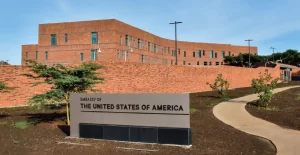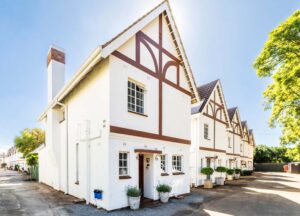THE site had been acquired in 2001 and years of intensive planning, research and development took place before the official groundbreaking ceremony in August 2015 to mark the start of the construction process. The groundbreaking ceremony was led by then Ambassador to Zimbabwe, Bruce Wharton, and was attended by then Minister of State for Harare metropolitan province, Miriam Chikukwa, Bernard Manyenyeni (Mayor of Harare at the time), local government and foreign affairs officials and embassy staff, among other dignitaries. Construction took approximately three years and has been estimated to cost around $290 million.
During the build over 700 local Zimbabwean contractors and service providers benefitted from employment and skills training. It was also a huge boost for local suppliers of building materials and related construction equipment. The NEC sits on just over 16 acres of land and will provide around 12,500 square metres of office space. The NEC is made up of several separate and distinct buildings which include the Chancery building, support services, a warehouse, a utilities building, the Marine Security Guard Residence, fitness facilities for the staff, as well as other outdoor seating and recreational areas.
The many different departments of the embassy had previously been spread across Harare in various rented premises so the NEC will help consolidate all their operations into one coherent venue in addition to improving security and making communications between various departments simpler and quicker. The project was developed and guided by the Bureau of Overseas Buildings Operations and B. L. Harbert International was the general contractor and project manager. B. L. Harbert is an international company committed to sustainable construction practices.
Although their projects cover just about all sectors of the construction industry they have a wealth of experience in building US Embassy Compounds and have managed the construction of Embassy Compounds around the world, including places like Mexico, Iraq, Morrocco, Kosovo and Swaziland, to mention just a few. The design architects were the huge international firm AECOM which has designed and delivered major projects around the world including skyscrapers, transit systems, stadiums and airports.
The Architects of Record were Page Southerland Page, Incorporated. The local partner was the Zimbabwean arm of ARUP, another huge multi-national involved in all sectors of the built environment. (ARUP Zimbabwe has been involved in the development of the iconic Eastgate Mall, the ZINARA road rehabilitation project, urban and rural planning, and the plans for the new Parliament in Mount Hampden.)
Internationally ARUP has been involved in one of the world’s largest urban renewal projects in Australia, high speed rail projects in the UK, waterfront projects in New York and the Mactan-Cebu International Airport in the Philippines, renewable energy projects, and many other innovative and unique programmes across the world. To come up with the design for the NEC the design architects AECOM did comprehensive research into the cultural, geographical and historical aspects of Zimbabwe.
The building design was inspired in part by the architectural motifs and materials of Great Zimbabwe and the landscape design was inspired by the rolling hills and plains of the central Highveld. MAIN PROFILE 13 In his remarks at the groundbreaking ceremony in 2015 then Ambassador Wharton remarked, “The buildings on the campus are conceived as a series of gomos (small hills) that animate the terrain.” At first glance of the exterior from Lorraine Drive, the buildings appear huge, solid and Behind the boundary wall the Chancery is divided into two separate wings – both gently curved – with open space flowing in between to suggest the open landscape of the Highveld. Wherever possible existing indigenous trees have been preserved, in particular a group of trees in the north east corner of the site. A number of other indigenous shade and flowering trees have been planted and will help soften the hard brick exteriors as they grow and develop. Most of the plants selected for the ornamental sections of the gardens are either indigenous or adapted water[1]wise shrubs or grasses to reduce both maintenance and irrigation. monolithic – almost brutalist – partly because of the almost unbroken facades of solid brick.
The first impression is of the great weight and volume of the structures. In a way it’s similar to the huge stone walls of Great Zimbabwe where a single material has been used and there is little obvious ornamentation and few openings. The NEC design does however make certain concessions – there are a number of window openings that break up the façade, although they are slightly irregular in size and placement. This is a very different style of architecture to the current fashionable trend of steel beams and vast sheets of glass! A closer look reveals that the height of exterior boundary wall gently undulates and swells up to full height above the main entrance – just like the hills of the Highveld landscape. The façade of the main building behind the entrance is curved evoking the curved wall of the Great Enclosure.
The buildings within the NEC are all designed with sustainable ‘green’ features. There is extensive use of renewable solar energy and the design of the offices incorporates daylight harvesting elements to reduce the need for interior lighting. The buildings also feature sunshades to reduce solar heat gain and glare and reduce the need for air-conditioning. There is a state of the art on-site waste water treatment plant, so water is recycled and waste water does not enter the municipal sewer system. They also make use of low consumption water fixtures to further reduce water use.
The buildings are contractually obliged to earn a minimum Silver Leadership in Energy and Environmental Design (LEED) Certification by the US Green Building Council. Also in his remarks at the ground breaking ceremony then Ambassador Wharton said, “LEED certification represents the highest standard of construction and design to minimize our environmental impact on Zimbabwe and maximize our contribution to sustained and responsible use of resources here, and reflects the US Government’s commitment to eco-diplomacy.” It would be wonderful if all new building projects in Zimbabwe adhered to such stringent environmental standards.
The NEC also houses an extensive art collection curated by the Office of Art in Embassies and features 29 works from artists from both the United States and Zimbabwe. Some of the Zimbabwean artists whose work is on display include the world renowned Virginia Chihota (who has exhibited at the Tate and the Saatchi Gallery), paintings by Charles Bhebe from Bulawayo and an assortment of sculptural installations by Moffat Takadiwa. There’s a work by American artist Robert Pruitt entitled “Forever’s People” depicting a group of seven figures intended to blend American and Zimbabwean identities, history and culture.
One of the most striking works is an installation by Israeli/American artist Yael Kanerek entitled Day/Night 2018. It’s a selection of brightly coloured letters in different languages which was specially commissioned to hang in the double volume space outside the canteen.
It will be interesting to see what impact the NEC will have on the surrounding suburban environment. There will no doubt be increased traffic in the area from both the Embassy staff and the public seeking services from the Embassy. Will the commuter omnibuses set up new routes to transport people from the CBD to the campus? Will the Westgate Shopping Mall and the Bluffhill Industrial Area experience a boost in business? What will happen to residential and commercial property prices? In any event the NEC represents both a huge investment and a commitment on behalf of the United States of America to a continued and growing relationship with us in Zimbabwe.
Incidentally, late last year the USA in co[1]operation with the National Museums and Monuments of Zimbabwe awarded a $475,000 grant to the World Monument Fund (WMF) for preservation work at Great Zimbabwe. At the award ceremony Ambassador Nichols said, “Our presence here in Zimbabwe continues to be a sign of the American people’s friendship and commitment to the people of Zimbabwe. As many of you know, we are building a new Embassy here in Zimbabwe, an Embassy modelled on Great Zimbabwe. Our project has injected more than $40 million into the Zimbabwean economy and employed over 1,200 Zimbabweans in its completion. We hope to move into our new Embassy in January and each time I walk through the doors I will think of the true Great Zimbabwe that is here. And I will be reminded of our unwavering commitment to the people and culture of Zimbabwe and the friendship between our two peoples.”
text by Michael Nott
photos by Nigel Wilson and Structure and Design
renders by BL Harbert









